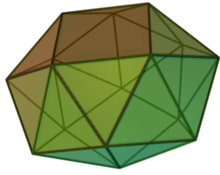Snub square antiprism
| Snub square antiprism | |
|---|---|
 | |
| Type | Johnson J84 – J85 – J86 |
| Faces | 24 triangles 2 squares |
| Edges | 40 |
| Vertices | 16 |
| Vertex configuration | |
| Symmetry group | |
| Properties | convex |
| Net | |
 | |

In geometry, the snub square antiprism is the Johnson solid that can be constructed by snubbing the square antiprism. It is one of the elementary Johnson solids that do not arise from "cut and paste" manipulations of the Platonic and Archimedean solids, although it is a relative of the icosahedron that has fourfold symmetry instead of threefold.
Construction and properties[edit]
The snub is the process of constructing polyhedra by cutting loose the edge's faces, twisting them, and then attaching equilateral triangles to their edges.[1] As the name suggested, the snub square antiprism is constructed by snubbing the square antiprism,[2] and this construction results in 24 equilateral triangles and 2 squares as its faces.[3] The Johnson solids are the convex polyhedra whose faces are regular, and the snub square antiprism is one of them, enumerated as , the 85th Johnson solid.[4]
Let be the positive root of the cubic polynomial
The surface area and volume of a snub square antiprism with edge length can be calculated as:[3]
References[edit]
- ^ Holme, Audun (2010). Geometry: Our Cultural Heritage. Springer. p. 99. doi:10.1007/978-3-642-14441-7. ISBN 978-3-642-14441-7.
- ^ a b Johnson, Norman W. (1966). "Convex polyhedra with regular faces". Canadian Journal of Mathematics. 18: 169–200. doi:10.4153/cjm-1966-021-8. MR 0185507. Zbl 0132.14603.
- ^ a b Berman, Martin (1971). "Regular-faced convex polyhedra". Journal of the Franklin Institute. 291 (5): 329–352. doi:10.1016/0016-0032(71)90071-8. MR 0290245.
- ^ Francis, Darryl (2013). "Johnson solids & their acronyms". Word Ways. 46 (3): 177.
- ^ Timofeenko, A. V. (2009). "The non-Platonic and non-Archimedean noncomposite polyhedra". Journal of Mathematical Science. 162 (5): 725. doi:10.1007/s10958-009-9655-0. S2CID 120114341.












